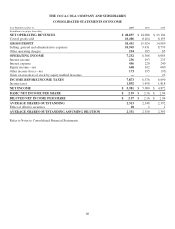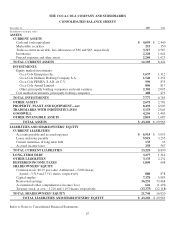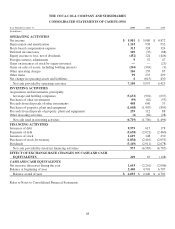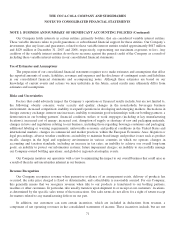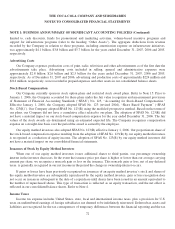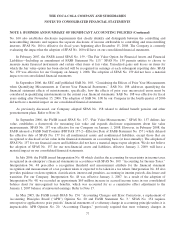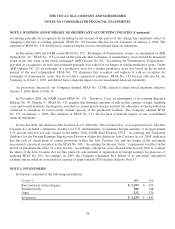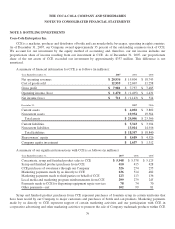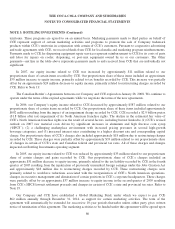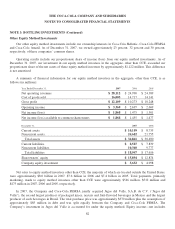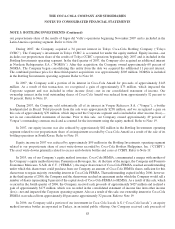Coca Cola 2007 Annual Report Download - page 77
Download and view the complete annual report
Please find page 77 of the 2007 Coca Cola annual report below. You can navigate through the pages in the report by either clicking on the pages listed below, or by using the keyword search tool below to find specific information within the annual report.THE COCA-COLA COMPANY AND SUBSIDIARIES
NOTES TO CONSOLIDATED FINANCIAL STATEMENTS
NOTE 1: BUSINESS AND SUMMARY OF SIGNIFICANT ACCOUNTING POLICIES (Continued)
decrease in market value of the assets or a significant change in the business conditions in a particular market. If we
determine that the carrying value of an asset is not recoverable based on expected undiscounted future cash flows,
excluding interest charges, we record an impairment loss equal to the excess of the carrying amount of the asset over its
fair value.
Goodwill, Trademarks and Other Intangible Assets
In accordance with SFAS No. 142, “Goodwill and Other Intangible Assets,” we classify intangible assets into three
categories: (1) intangible assets with definite lives subject to amortization, (2) intangible assets with indefinite lives not
subject to amortization, and (3) goodwill. We test intangible assets with definite lives for impairment if conditions exist
that indicate the carrying value may not be recoverable. Such conditions may include an economic downturn in a
geographic market or a change in the assessment of future operations. We record an impairment charge when the carrying
value of the definite-lived intangible asset is not recoverable by the cash flows generated from the use of the asset.
Intangible assets with indefinite lives and goodwill are not amortized. We test these intangible assets and goodwill
for impairment at least annually or more frequently if events or circumstances indicate that such intangible assets or
goodwill might be impaired. Such tests for impairment are also required for intangible assets with indefinite lives
and/or goodwill recorded by our equity method investees. All goodwill is assigned to reporting units, which are one
level below our operating segments. Goodwill is assigned to the reporting unit that benefits from the synergies arising
from each business combination. We perform our impairment tests of goodwill at our reporting unit level. Such
impairment tests for goodwill include comparing the fair value of the respective reporting unit with its carrying value,
including goodwill. We use a variety of methodologies in conducting these impairment tests, including discounted cash
flow analyses with a number of scenarios, where applicable, that are weighted based on the probability of different
outcomes. When appropriate, we consider the assumptions that we believe hypothetical marketplace participants would
use in estimating future cash flows. In addition, where applicable, an appropriate discount rate is used, based on the
Company’s cost of capital rate or location-specific economic factors. When the fair value is less than the carrying value
of the intangible assets or the reporting unit, we record an impairment charge to reduce the carrying value of the assets
to fair value. These impairment charges are generally recorded in the line item other operating charges or, to the extent
they relate to equity method investees, as a reduction of equity income—net, in the consolidated statements of income.
Our Company determines the useful lives of our identifiable intangible assets after considering the specific facts
and circumstances related to each intangible asset. Factors we consider when determining useful lives include the
contractual term of any agreement, the history of the asset, the Company’s long-term strategy for the use of the asset,
any laws or other local regulations which could impact the useful life of the asset, and other economic factors,
including competition and specific market conditions. Intangible assets that are deemed to have definite lives are
amortized, primarily on a straight-line basis, over their useful lives, generally ranging from 1 to 20 years. Refer to
Note 6.
Derivative Financial Instruments
Our Company accounts for derivative financial instruments in accordance with SFAS No. 133, “Accounting for
Derivative Instruments and Hedging Activities,” as amended by SFAS No. 137, “Accounting for Derivative
Instruments and Hedging Activities—Deferral of the Effective Date of FASB Statement No. 133—an amendment of
FASB Statement No. 133,” SFAS No. 138, “Accounting for Certain Derivative Instruments and Certain Hedging
Activities—an amendment of FASB Statement No. 133,” and SFAS No. 149, “Amendment of Statement 133 on
Derivative Instruments and Hedging Activities.” We recognize all derivative instruments as either assets or liabilities at
75



